词素分类word版
词素分类

词素前缀一、否定前缀1.纯否定not①a-②dis-③in-④non-⑤un-2.倒转,去除to reverse, to remove①de-②dis-③un-3.反对,抗,相对against, opposite to①anti-②contra-③counter-④ob-二、空间方位前缀1.前←→后前①ante- (before)②fore-(before)③pre- (before)④pro- (forward)后①post-(after)②re-(backward)③retro- (backward)2.上←→下上①over-(above, on; excessive, toomuch)②super-(above, beyond)③sur- (over, above)④hyper-(excessive, too much)⑤epi- (above)下①sub-(undre)②de-(down)③under- (below; less than)④hypo-(under, beneath)⑤infra- (below)3.内←→外内①in-(in, enter)②im-(in, inward, enter)③intro- (in, inward)④intra-(inside)⑤en- (in)em- (b, m, p前)外①e-(out)②ex-(out)③extra- (outside of, beyond)④ultra-(beyond)⑤out- (surpassing, out)4.中间←→周围中间①inter-(between)②mid-(in the middle of)周围①circum-(round, around)三、对比前缀1.大←→小大①macro- (large)②mega-(large)③magn- (big, great)小①micro- (very small)②mini- (small)2.多←→少多①multi- (many)②poly-(many)少①under- (less than, not enough)3.好←→坏好①bene- (good, well)②eu-(good, well)坏①mal- (bad)male-②mis- (bad)4.新←→旧新①neo- (new)旧①old- (very small)②pale- (very old, of ancient time)paleo-5.朝向←→离开朝向①ad- (to, toward)离开①ab- (away, off)②di- (away)6.相同←→不同相同①homo- (same)不同①hetero- (different)7.聚合←→分散聚合①co- (together)②syn-(together, same)sym-分散①dis- (apart)②se- (apart)8.正确←→错误正确①ortho- (right, straight)错误①mis- (wrong)9.喜爱←→憎恶喜爱①phil- (liking, fond of)憎恶①mis- (hate)10.全←→半全①holo- (complete)②omni-(all or everywhere)③pan- (all)半①half-②semi- (half, partially)③hemi- (half)④demi- (half)四、数字前缀1.一①mono- (one, single)②uni-(one, single)2.二①bi- (two, twice)②twi-(two)③di- (two, double)du-④ambi-(both)⑤amphi- (both)3.三①tri- (three)4.四①quadri- (four)②quarter-(one fourth)5.五①penta- (five)②quinque-(five)6.六①sex- (six)②hexa-(six)7.七①hepta- (seven)8.八①octa- (eight)9.九①nona- (nine)10.十①deca- (ten)heci-11.百①hecto- (hundred)②centi-(hundred)12.千①kilo- (thousand)②milli-(thousand)13.万①myria-14.百万,兆,大量①mega- (six)五、其他前缀1.横过(到对面),穿过①dia- (through, across)②trans-(through, across)③per- (through, across)2.自己,自动①auto-(self)3.心灵,精神,心理①psycho- (mind)4.假的,伪的①pseudo- (false)5.继(无血缘关系)①step- (not by blood)6.改变①trans- (change)7.远①tele- (far, distant)六、改变词性前缀1.a-①将动词变成谓语性形容词alike②将名词变成副词ahead③将名词变成动词amass2.be-①在名词或形容词前,构成及物动词befriend②构成一些介词before3.en- (b, p, m 前为em-)①构成动词enable七、多义前缀1.a-①改变词性②否定not③状态④place where2.ad-①to toward②again, to add3.be-①改变词性②构成介词4.de-①to remove, to reverse②down5.di- (du-)①two, double②away6.dis-①not②to reverse, to remove③apart7.en- (em- b, p, m前)①in②构成动词8.ad-①out②former9.in- (im- b, p, m前)①not②inside, to enter10.mis-①bad②wrong③to hate11.over-①above, on②excessive, too much12.re-①to undo, to reverse②backward③again13.trans-①across②through③to change14.un-①not②to reverse15.under-①beneath, below②less, not enough后缀一、名词后缀1.表示“人”1)inhabitants or dwellers①-an②-er③-ese2)belonging to a certain occupation①-ian (c, y结尾的形容词或名词后)②-er3) a supporter or believer of a doctrine①-an②-arian③-ist4)one who does or performs an act①-ar②-ary③-ate④-ator⑤-ist⑥-ee⑦-eer⑧-or5)to denote a specific feeling①-ster(a bad sense 贬义)②-y(dearness 亲昵)6)To form a feminine noun①-ess2.抽象1)state or quality①-ance, -ancy附在-ant结尾的形容词后附在动词词根后②-ence, -ency附在-ent结尾的形容词后③-cy附在-te, -tic结尾的词干后④-ability附在-able结尾的形容词后⑤-ibility附在-ible结尾的形容词后⑥-ness附在形容词后2)the action & the result of the action①-al (the act of)②-ion, -sion, -tion③-ment (the result of an action)④-ure (action or result)3)indicate abstract concepts①-ship (state or condition of)②-th③-tude4)power, rule, government①-cracy5)action, state or condition, doctrines,example of a use①-ism6)state, condition①-hood②-age7)relationship, status, identity①-ship3.学科①-ic, -ics②-logy4.物质(物品和工具)①-al②-er③-ery5.细小①-cle②-en③-ette④-ling⑤-let二、形容词后缀1.可……的,能……的,易于……的1)-able2)-ible3)-ile2.如……的,似……的,……形状的1)-esque2)-ish3)-like4)-y5)-ly3.有……的,多……的1)-ed2)-ful3)-ous4)-y4.属于……的,与……有关的1)-al2)-an3)-ar4)-ial5)-ic6)-tic7)-ual5.具有……性质的1)-acious2)-aneous3)-ant4)-ar5)-ary6)-ate7)-ative8)-atory9)-ed10)-fic11)-ful12)-ical13)-id14)-ious15)-ite16)-itive17)-ive18)-ly19)-ory20)-ous21)-some6.某国的,某地的1)-an2)-ese3)-ian4)-ish7.其它1)-ing①使……的excit ing②正……在的develop ing2)-ed①已……的retir ed②受……的educat ed3)-ish 略……的,稍……的green ish cold ish4)-less 无……的use less5)-proof 防……的,不透……的water proof air proof三、动词后缀1.to make; to cause to become①-ate②-en③-fy④-ish⑤-ize⑥-ise (BrE)2.repeated or continuous action①-er3.onomatopoeic action①-sh四、副词后缀1.方式,方法,状态,……地①-ably②–ibly③–ly (一般加在形容词后)2.表示方向①-ward②-wise五、多义后缀1.-al①与……有关,有……的特点autumn al②……的行为refus al③物品manu al2.-an①……国(人)Europe an②支持(信仰)……的Christi an③职业librari an3.-ar①加在名词后,构成形容词singul ar②加在动词后,构成名词li ar4.-ate①表现出……的,充满……的consider ate②使……,使成为……regul ate③机构或部门consul ate5.-er①加在动词后,构成名词fertiliz er②职业,工作bank er③……地方或国家的人northern er④构成形容词或副词比较级small er hard er6.-ish①像……一样的,有……特点的snobb ish②……国的,……语的Brit ish Engl ish③沉迷于……的,倾向于……的book ish④稍许,有点儿sweet ish⑤动词后缀nour ish7.-ism①加在动词后,构成名词critic ism②动作,事业tour ism③状态,状况alcohol ism④学说,主义,信条social ism⑤语言上的用法和特点wittic ism8.-ly①加在形容词后,构成副词gradual ly②加在表示时间的名词前,构成形容词或副词;每……的week ly③像……一样的,具有……性质的world ly9.-ment①行为move ment②行为的结果、状态refresh ment③行为后的具体产物pave ment10.-ship①状态,身份member ship②技巧,能力leader ship③关系kin ship11.-y①有……的,表现出……的,像……一样的silver y②亲昵mumm y③加在动词后,构成名词。
英语单词词素分析

第十八页,共89页
3. monovalent 单价的 bivalent__________ trivalent__________ quadravalent_______ pentavalent________ sexivalent_________ heptavalent________ octavalent_________
与方法并重” 的思路。
第二十七页,共89页
常见词根a,b
aer, aero, aeri=air
aerial空气的 / aeroplane飞机
agri, agro, agr=field, land, 表示“田地,农业”等
alt = high高
altitude高度
anim = life生命
animal动物/ animate使…生机勃勃
与表示事物的词根: cycle (环) later (边) ped / pod(足) gon (角) hedron (体) ode (级管) sect (切分) gram (写、画) ann / enn(年) valent (化合价)
等编成一组,它们可以按照特定的规律结合成若干英语单词,若再配上
第十四页,共89页
第三十页,共89页
agriculture
农业(agri+culture培养)
agrimotor 农用拖拉机(agri+motor机动车)
agrobiology
农业生物学(agro+bilolgy生物学) inanimate
无生命的(in无+anim+ate生命)
magnanimous
annu(enni) = year年 anniversary周年纪念 / annual年度的
(完整word版)英语语法体系一览图

词素
词的构成
构词法综述(分类, 助动词)
名词时/体
动词语气不定式
实词形容词非限定形式-ing分词
副词语态-ed分词
数词
词的分类叹词
连词
介词
虚词代词
冠词
语法句子成分主语从句
简单句基本句型宾语从句句子结构分类并列句名词性从句主补从句
复合句主从复合句形容词性从句同位语从句
副词性从句
陈述句
一般疑问句
功能分类疑问句特殊疑问句
祈使句选择疑问句
感叹句附加疑问句
主谓一致
直接/间接引语
否定
省略
强调, 前置与倒装
, 时态一致等)。
(完整版)英语常用词素表

(完整版)英语常⽤词素表英语常⽤词素表⼀.常见的前缀(1)表⽰数量的前缀1)semi-(L) hemi (G) 半semiannually semicolon semi-colonial semi-conductor semimonthly semiautomatic semi-feudal semifinal semiliterate semiofficial semiweekly hemisphere semitransparent semi-sphere semi-cycle2)uni-(L)⼀uniform unilateral unanimous⼀致的unique unionunison unit unite unity unisex universe university3)mono-(GK)⼀monotonous 单调的monograph专题论⽂monopoly垄断monologue独⽩monorail 单轨monogamy ⼀夫⼀妻制monosyllable 单⾳节monolateral单边monodrama独⾓戏monologist独⾓戏表演者monolingual单语的monochrome 单⾊monocrop单⼀作物monocultural ⽂化单⼀的monarch君主monoculture单种栽培monographer专著作家monology 独语僻4)bi-(L)⼆bicycle binocular biweekly bimonthly bilateral biplanebinary bilingual bipartisan bicentennial bichrome bigamy bicolor bicorn bicultural bicyclist biceps⼆头肌biconditional bicommunal5)di(GK)⼆dialogue dioxide diode dilemma diphthong dialinguistics(双语学) 6)ambi-(L)⼆ambidextrous双⼿熟练的ambiguous模棱两可的ambivalence ⽭盾⼼理ambiguity歧义ambilingual双语的ambisexual两性⼈ambisyllable双⾳节ambitendency⽭盾⼼理ambivert中间性格ambiversion中间性格ambisonics⾼保真度⽴体声复制7) amphi (GK) ⼆amphibian两栖amphichromatic双⾊的amphibology(语⾔模棱两可)8)tri (GK,L)三triangle trigonometry tripod trilogy triode triple tricycle9)deci-(L) ⼗分之⼀decimeter deciliter decibel decimal decigram10)deca-(GK),⼗decade decameron decagon decimeter11)centi-(L)百分之⼀centigrade cent century centennial centipede12)kilo-(GK) 千kilometer kilogram kilowatt kilocycle13) milli-(L)千millimeter milligram millennium14) myria(GK) 万myriameter myriorama myriad15)mega(GK)百万megacycle megaphone megaton16)micro-(GK)百万分之⼀micro-organism micro-wave microwave micro-filmmicro-print micro-climate micro-balance micro-switchmicro-surgery micro-book micro-world micro-particlemicro-crack micro-file micro-crobe micro-explosionmicro-earthquake micro-electronics micro-phone micro-scopemicro-chemistry microwave microcode microcomputer17)multi-(L) 多multiple choice multi-national multitude multiplymulti-purpose multiracial multilateral multi-polarmulti-molecular multi-channel multiform multi-headmulti-centric multi-role multiparty multiplemultiple store multiprobe multitasking multiversity18)poly-(GK)多polytechnical polyclinic polygamy polycentricpolymer Polynesia polysemy polysyllablepolygon polypoly polyandry polycentrist19)mini-(L)⼩minibus minicrystal minicoat miniboomminicomputer miniwatergate minisummit minicamminicab ministate minipark minitrainminiwar minitype minigun minicarminiskirt minicrisis minikin minimalminiature minify minimize minimumminister minipants minor minorityminus minute20) maxi-(L) ⼤maxicoat maxiskirt maxiorder maximummaxishorts maximize maximal maximazation(2) 表⽰否定的前缀1)a-(变体为an,⽤在元⾳之前)(GK)表⽰缺乏某种性质。
(完整word版)生物专业英语词汇必备

生物专业英语词汇-词素(词根)部分一、表示数量的词素1。
haplo,mono,uni 单,一,独haploid 单倍体monoxide一氧化碳monoatomic单原子的2. bi,di,dipl,twi,du:二,双,两,偶biocolor 双色,dichromatic 双色的,diplobacillus 双杆菌dikaryon 双核体twin 孪生dual 双重的3. tri 三,丙Triple 三倍的triangle三角triacylglycerol三酰甘油tricarboxylic acid cycle 三羧酸循环4. quadri,quadru,quart,tetr,tetra:四Quadruple 四倍的quadrilateral四边的quadrivalent四价的quadruped四足动物tetrode四极管tetracycline四环素5。
pent, penta, quique五pentose戊糖pentagon五角形pentane戊烷quintuple 五倍的pentose戊糖pentomer五邻粒6。
hex,hexa,sex 六hexose已糖hexapod六足动物hexapoda昆虫纲hexamer六聚体7. hepta,sept(i)七heptane 庚烷heptose 庚糖heptoglobin七珠蛋白8。
oct八octpus 章鱼octagon八角形octane 辛烷octase 辛糖9。
enne, nona九nonapeptide 九肽enneahedron 九面体10。
deca, deka :十decapod 十足目动物decahedron 十面体decagram 十克11. hecto,百hectometer百米hectoliter百升hectowatt 百瓦12. kilo,千kilodalton (KD) 千道尔顿kilobase 千碱基kiloelectron volt 千电子伏特13. deci,十分之一,分decimeter 分米decigram 十分之一克14. centi,百分之一15. milli,千分之一,毫millimole 毫摩(尔)milliliter 毫升16. micro,百万分之一,微,微小,微量microgram微克microogranism微生物microecology微生态学micropipet微量移液器17。
(完整word版)现代英语词汇学概论最强版复习资料chapter2英语词汇的形态结构
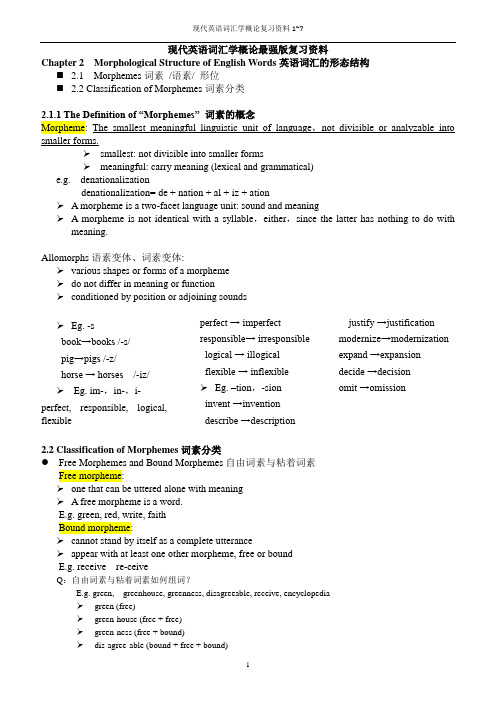
现代英语词汇学概论复习资料1~7现代英语词汇学概论最强版复习资料Chapter 2 Morphological Structure of English Words英语词汇的形态结构⏹ 2.1 Morphemes词素/语素/ 形位⏹ 2.2 Classification of Morphemes词素分类2.1.1 The Definition of “Morphemes” 词素的概念Morpheme: The smallest meaningful linguistic unit of language,not divisible or analyzable into smaller forms.➢smallest: not divisible into smaller forms➢meaningful: carry meaning (lexical and grammatical)e.g. denationalizationdenationalization= de + nation + al + iz + ation➢ A morpheme is a two-facet language unit: sound and meaning➢ A morpheme is not identical with a syllable,either,since the latter has nothing to do with meaning.Allomorphs语素变体、词素变体:➢various shapes or forms of a morpheme➢do not differ in meaning or function➢conditioned by position or adjoining sounds➢Eg. -sbook→books /-s/pig→pigs /-z/horse → horses /-iz/➢Eg. im-,in-,i- perfect, responsible, logical, flexible perfect → imperfectresponsible→ irresponsiblelogical → illogicalflexible → inflexible➢Eg. –tion,-sioninvent →inventiondescribe →descriptionjustify →justificationmodernize→modernizationexpand →expansiondecide →decisionomit →omission2.2 Classification of Morphemes词素分类●Free Morphemes and Bound Morphemes自由词素与粘着词素Free morpheme:➢one that can be uttered alone with meaning➢ A free morpheme is a word.E.g. green, red, write, faithBound morpheme:➢cannot stand by itself as a complete utterance➢appear with at least one other morpheme, free or boundE.g. receive re-ceiveQ:自由词素与粘着词素如何组词?E.g. green, greenhouse, greenness, disagreeable, receive, encyclopedia➢green (free)➢green-house (free + free)➢green-ness (free + bound)➢re-ceive (bound + bound)➢en-cyclo-pedia (bound + bound + bound)* A free morpheme is a word.●Roots and Affixes词根与词缀Root 词根: The basic unchangeable part of a word, and it conveys the main lexical meaning of the word.➢ 1. Free root (自由词根):A word consist of one free root (or one morpheme)is a simple word.Free roots provide the English language with a basis for the formation of new words.➢ 2. Bound root(粘着词根):roots derived from foreign sources ,esp. from Greek and Latin, belong to the class of bound morphemes, such as tian and cieveEg.1)work, workable, worker, worked, working (free)2) contain, detain, retaintain= tenere (L) = to hold (bound)3) conceive, deceive, receiveceive= capere (L) = to take (bound)4) revive, vitamin, vital, vivacious, vividvit, viv = life / to live (bound)➢Vital:necessary in order to stay alive-al: pertaining to = have a connection withvital = having a connection with life Vivacious:adj. apprec. full of life and high spirits; lively-ous: full ofvivacous = full of life (energy)Vivid:producing sharp clear pictures in the mind; lifelike-id: having a certain qualityvivid = having a certain quality of lifeAffixes缀: a collective term for the type of formative that can be used when added to another morpheme.➢ 1. Inflectional affixes(屈折词缀): serves to express such meanings as plurality, tense, and the comparative or superlative degree.特点:1.not to form a new word with new lexical meaning2. having only particular grammatical meaning3. only to be affixed to words of the same word-class (not to change the word-class)➢ E.g. Plural marker: pens, oxen, feetGenitive case: Jame’sVerbal endings: works, working, worked, bought, saidComparative and superlative degree: slower, slowest➢ 2. Derivational affixes(派生词缀):to be added to another morpheme to derive a new word 特点:1. to derive a new word2. having a specific lexical meaning (some also affective meaning)3. some to be attached to words of different word classes➢Eg. Having pejorative or derogatory meaning-ism means“doctrine or point of view ”==socialismPro-means“on the side of ”==pro-com-munist⏹Mini-carmean-nessModern-izeSocial-ism Pro-communist De-codeDe-valueWash-able⏹mis-mal-absorptionpseudo-democratic hire-ling weak-ling child-ish派生词缀分类(derivational morphemes): Prefixes and suffixes1) By linguistic origin:➢Native affixes➢Foreign affixes2) By productivity:➢Productive/living affixes➢Unproductive/dead affixes➢Summary➢ 2.Morphological Structure of English Words英语词汇的形态➢ 2.1 Morphemes词素➢ 1.The Definition of “Morphemes”词素的概念➢ 2. Allomorphs 词素变体➢ 2.2 Classification of Morphemes 词素分类➢ 1. Free Morphemes and Bound Morphemes➢自由词素与粘着词素➢ 2. Roots and Affixes 词根与词缀➢free root and bound root自由词根与粘着词根➢inflectional affixes and derivational affixes屈折词缀与派生词缀➢➢。
(完整word版)Chapter-3-Morphology--形态学(现代语言学)
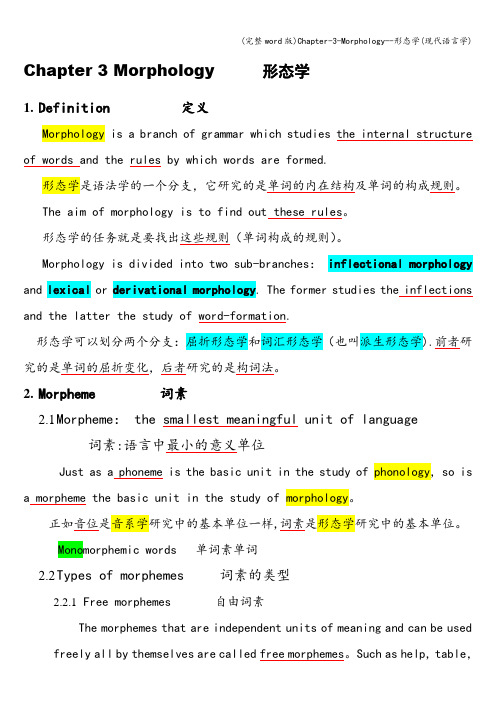
Chapter 3 Morphology 形态学1.Definition 定义Morphology is a branch of grammar which studies the internal structure of words and the rules by which words are formed.形态学是语法学的一个分支,它研究的是单词的内在结构及单词的构成规则。
The aim of morphology is to find out these rules。
形态学的任务就是要找出这些规则(单词构成的规则)。
Morphology is divided into two sub-branches:inflectional morphology and lexical or derivational morphology. The former studies the inflections and the latter the study of word-formation.形态学可以划分两个分支:屈折形态学和词汇形态学(也叫派生形态学).前者研究的是单词的屈折变化,后者研究的是构词法。
2.Morpheme 词素2.1Morpheme: the smallest meaningful unit of language词素:语言中最小的意义单位Just as a phoneme is the basic unit in the study of phonology, so is a morpheme the basic unit in the study of morphology。
正如音位是音系学研究中的基本单位一样,词素是形态学研究中的基本单位。
Monomorphemic words 单词素单词2.2Types of morphemes 词素的类型2.2.1Free morphemes 自由词素The morphemes that are independent units of meaning and can be used freely all by themselves are called free morphemes。
词素解析

词素及词的构成词素语言中最小的字义单位词素/语素是最小的音义结合体,其最大的特点是不能再被分割为更小的音义结合体。
意思或语法功能的最小单位。
(Morpheme:the smallest meani ngful unit of language./the smallest unit of meaning that a word can be divided into)词素与词的关系那就是“词素的功能是构成词”。
词是由语素组成的最小的造句单位。
letter(字母)-morpheme(词素)-word(单词)-phrase-(短语)-expressi on(措辞,表达方式)-sentence(句子)Morphemeroot词根: [C]the part of a word that has the main meaning and t hat its other forms are based on;a word that other words are fo rmed from. <linguistics 语言学〉词根是最小意义的语言单位,去掉所有的词缀后,词所剩下的那部分就是词根。
词根分为自由词根和粘着词根。
affix: prefix、suffix(postfix)词缀:前缀、后缀词干:stem (grammar 语法) the main part of a word that stays the same when endings are added to it.词干是指能加上曲折词缀的语素或语素的组合。
词基:base 词基是可添加词缀的一种词的形式。
词根是最小的语义单位,是一个词的中心含义。
传统观点认为词干只和曲折变化有关,也就是说只有添加曲折变化词缀的形式才能叫做词干,而添加派生词缀的形式职能就称作词基了。
曲折:是指根据语法规则给一个词添加词缀或进行其他改变的过程。
英语中的曲折词缀通常都是后缀。
1.词素和词
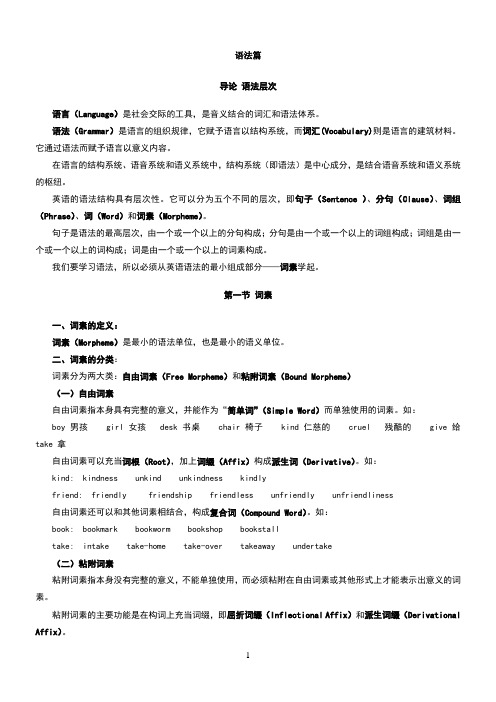
语法篇导论语法层次语言(Language)是社会交际的工具,是音义结合的词汇和语法体系。
语法(Grammar)是语言的组织规律,它赋予语言以结构系统,而词汇(Vocabulary)则是语言的建筑材料。
它通过语法而赋予语言以意义内容。
在语言的结构系统、语音系统和语义系统中,结构系统(即语法)是中心成分,是结合语音系统和语义系统的枢纽。
英语的语法结构具有层次性。
它可以分为五个不同的层次,即句子(Sentence )、分句(Clause)、词组(Phrase)、词(Word)和词素(Morpheme)。
句子是语法的最高层次,由一个或一个以上的分句构成;分句是由一个或一个以上的词组构成;词组是由一个或一个以上的词构成;词是由一个或一个以上的词素构成。
我们要学习语法,所以必须从英语语法的最小组成部分——词素学起。
第一节词素一、词素的定义:词素(Morpheme)是最小的语法单位,也是最小的语义单位。
二、词素的分类:词素分为两大类:自由词素(Free Morpheme)和粘附词素(Bound Morpheme)(一)自由词素自由词素指本身具有完整的意义,并能作为“简单词”(Simple Word)而单独使用的词素。
如:boy 男孩 girl 女孩 desk 书桌 chair 椅子 kind 仁慈的 cruel 残酷的 give给take 拿自由词素可以充当词根(Root),加上词缀(Affix)构成派生词(Derivative)。
如:kind: kindness unkind unkindness kindlyfriend: friendly friendship friendless unfriendly unfriendliness自由词素还可以和其他词素相结合,构成复合词(Compound Word)。
如:book: bookmark bookworm bookshop bookstalltake: intake take-home take-over takeaway undertake(二)粘附词素粘附词素指本身没有完整的意义,不能单独使用,而必须粘附在自由词素或其他形式上才能表示出意义的词素。
英语单词的结构

英语单词的结构语言学家把例如词典的每个词条(entry)叫做词位(lexeme),把词的不同形状叫做词形(word form)。
把一个词形跟一个意义的结合叫做一个词汇单位(lexical unit)。
词素:是词的组成成分,是语言中的语音和语义的最小结合体。
词素的分类:根据能否独立使用1、自由词素Free form:具有完整的词汇意义、能够单独构成一个词的独立使用的词素。
Walk, table, bad, lamp, elephant.2、黏附词素Bound form:具有一定意义、但不能单独存在、必须黏附在其他形式上的词素。
Toler-, -ish.词素变体allomorph:同一词素在不同的构词环境中可以有不同变体。
词素的变体可以有不同的读音和拼法。
如:自由词素go的变体为went和gone;黏附词素in-的变体为im-,il-,ir-。
根据所含的词义:词根root:所含明确的词汇意义,在单词中表达主要的意义:book, case, toler-, tele-, -scope, -gram, communic-.自由词根free root:词根中可以单独使用的,book和case。
前面所提到的自由词素都是自由词根。
粘着词根bound boot:不能单独使用,必须与其他词素结合才能构成的词,如:toler-, tele-, -scope, -gram, communic-.前面所提到的黏附词素都是粘着词根。
词缀affix:只有语法意义没有词汇意义的词素,或者虽有一定的词汇意义、但在词中只表达次要的意义的词素,如复数名词加的-s,名词所有格-’s,表示过去式或者过去分词-ed,现在分词和动名词-ing,第三人称-s,某些形容词和副词的比较级-er和最高级-est,以及这些词缀的变体。
屈折词缀inflectional affix:这表达语法范畴,是词的语法功能的标记。
词加上屈折词缀只是引起词的形态变化。
词素分类
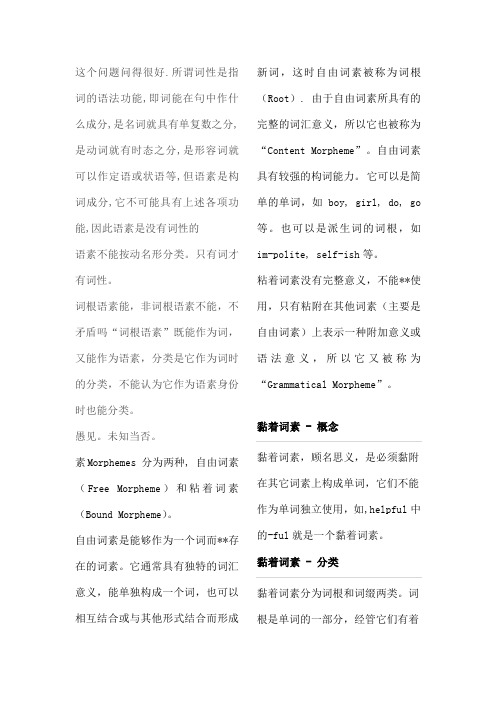
这个问题问得很好.所谓词性是指词的语法功能,即词能在句中作什么成分,是名词就具有单复数之分,是动词就有时态之分,是形容词就可以作定语或状语等,但语素是构词成分,它不可能具有上述各项功能,因此语素是没有词性的语素不能按动名形分类。
只有词才有词性。
词根语素能,非词根语素不能,不矛盾吗“词根语素”既能作为词,又能作为语素,分类是它作为词时的分类,不能认为它作为语素身份时也能分类。
愚见。
未知当否。
素Morphemes 分为两种, 自由词素(Free Morpheme)和粘着词素(Bound Morpheme)。
自由词素是能够作为一个词而**存在的词素。
它通常具有独特的词汇意义,能单独构成一个词,也可以相互结合或与其他形式结合而形成新词,这时自由词素被称为词根(Root). 由于自由词素所具有的完整的词汇意义,所以它也被称为“Content Morpheme”。
自由词素具有较强的构词能力。
它可以是简单的单词,如boy, girl, do, go 等。
也可以是派生词的词根,如im-polite, self-ish等。
粘着词素没有完整意义,不能**使用,只有粘附在其他词素(主要是自由词素)上表示一种附加意义或语法意义,所以它又被称为“Grammatical Morpheme”。
黏着词素,顾名思义,是必须黏附在其它词素上构成单词,它们不能作为单词独立使用,如,helpful中的-ful就是一个黏着词素。
黏着词素分为词根和词缀两类。
词根是单词的一部分,经管它们有着明确的语义,但是它们不能单独使用,必须和其它词素或词根结合使用构成单词。
例如;在单词anteced?中,ante- 是前缀,表示before, -ced-是词根,意思是go, -ent是后缀,表示a thing or a person。
词素前缀一、否定前缀1.纯否定 not①a-②dis-③in-④non-⑤un-2.倒转,去除 to reverse, toremove①de-②dis-③un-3.反对,抗,相对 against,opposite to①anti-②contra-③counter-④ob-二、空间方位前缀1.前←→后前①ante- (before)②fore- (before)③pre- (before)④pro- (forward)后①post- (after)②re- (backward)③retro- (backward)2.上←→下上①over- (above, on;excessive, too much)②super- (above,beyond)③sur- (over, above)④hyper- (excessive,too much)⑤epi- (above)下①sub- (undre)②de- (down)③under- (below; lessthan)④hypo- (under,beneath)⑤infra- (below)3.内←→外内①in- (in, enter)②im- (in, inward,enter)③intro- (in, inward)④intra- (inside)⑤en- (in)em- (b, m, p前)外①e- (out)②ex- (out)③extra- (outside of,beyond)④ultra- (beyond)⑤out- (surpassing,out)4.中间←→周围中间①inter- (between)②mid- (in the middleof)周围①circum- (round,around)三、对比前缀1.大←→小大①macro- (large)②mega- (large)③magn- (big, great)小①micro- (very small)②mini- (small)2.多←→少多①multi- (many)②poly- (many)少①under- (less than,not enough)3.好←→坏好①bene- (good, well)②eu- (good, well)坏①mal- (bad)male-②mis- (bad)4.新←→旧新①neo- (new)旧①old- (very small)②pale- (very old, ofancient time)paleo-5.朝向←→离开朝向①ad- (to, toward)离开①ab- (away, off)②di- (away)6.相同←→不同相同①homo- (same)不同①hetero- (different)7.聚合←→分散聚合①co- (together)②syn- (together,same)sym-分散①dis- (apart)②se- (apart)8.正确←→错误正确①ortho- (right,straight)错误①mis- (wrong)9.喜爱←→憎恶喜爱①phil- (liking, fondof)憎恶①mis- (hate)10.全←→半全①holo- (complete)②omni- (all oreverywhere)③pan- (all)半①half-②semi- (half,partially)③hemi- (half)④demi- (half)四、数字前缀1.一①mono- (one, single)②uni- (one, single)二①bi- (two, twice)②twi- (two)③di- (two, double)du-④ambi- (both)⑤amphi- (both)2.三①tri- (three)3.四①quadri- (four)②quarter- (onefourth)4.五①penta- (five)②quinque- (five)5.六①sex- (six)②hexa- (six)6.七①hepta- (seven)7.八①octa- (eight)8.九①nona- (nine)9.十①deca- (ten)heci-10.百①hecto- (hundred)②centi- (hundred)11.千①kilo- (thousand)②milli- (thousand)12.万①myria-13.百万,兆,大量①mega- (six)五、其他前缀1.横过(到对面),穿过①dia- (through,across)②trans- (through,across)③per- (through,across)2.自己,自动①auto- (self)3.心灵,精神,心理①psycho- (mind)4.假的,伪的①pseudo- (false)5.继(无血缘关系)①step- (not by blood)6.改变①trans- (change)7.远①tele- (far, distant)六、改变词性前缀1.a-①将动词变成谓语性形容词alike②将名词变成副词ahead③将名词变成动词amass2.be-①在名词或形容词前,构成及物动词befriend②构成一些介词before3.en- (b, p, m 前为em-)①构成动词enable七、多义前缀1.a-①改变词性②否定 not③状态④place where2.ad-①to toward②again, to add3.be-①改变词性②构成介词4.de-①to remove, to reverse②down5.di- (du-)①two, double②away6.dis-①not②to reverse, to remove③apart7.en- (em- b, p, m前)①in②构成动词8.ad-①out②former 9.in- (im- b, p, m前)①not②inside, to enter10.mis-①bad②wrong③to hate11.over-①above, on②excessive, too much12.re-①to undo, to reverse②backward③again13.trans-①across②through③to change14.un-①not②to reverse15.under-①beneath, below②less, not enough后缀一、名词后缀1.表示“人”1)inhabitants or dwellers①-an②-er③-ese2)belonging to a certainoccupation①-ian (c, y结尾的形容词或名词后)②-er3) a supporter or believerof a doctrine①-an②-arian③-ist4)one who does or performsan act①-ar②-ary③-ate④-ator⑤-ist⑥-ee⑦-eer⑧-or5)to denote a specificfeeling①-ster (a bad sense 贬义)②-y (dearness 亲昵)6)To form a feminine noun①-ess2.抽象1)state or quality①-ance, -ancy附在-ant结尾的形容词后附在动词词根后②-ence, -ency附在-ent结尾的形容词后③-cy附在-te, -tic结尾的词干后④-ability附在-able结尾的形容词后⑤-ibility附在-ible结尾的形容词后⑥-ness附在形容词后2)the action & the result ofthe action①-al (the act of)②-ion, -sion, -tion③-ment (the result ofan action)④-ure (action orresult)3)indicate abstractconcepts①-ship (state orcondition of)②-th③-tude4)power, rule, government①-cracy5)action, state orcondition, doctrines,example of a use①-ism6)state, condition①-hood②-age7)relationship, status,identity①-ship3.学科①-ic, -ics②-logy4.物质(物品和工具)①-al②-er③-ery5.细小①-cle②-en③-ette④-ling⑤-let二、形容词后缀1.可……的,能……的,易于……的1)-able2)-ible3)-ile2.如……的,似……的,……形状的1)-esque2)-ish3)-like4)-y5)-ly3.有……的,多……的1)-ed2)-ful3)-ous4)-y4.属于……的,与……有关的1)-al2)-an3)-ar4)-ial5)-ic6)-tic7)-ual5.具有……性质的1)-acious2)-aneous3)-ant4)-ar5)-ary6)-ate7)-ative8)-atory9)-ed10)-fic11)-ful12)-ical13)-id14)-ious15)-ite16)-itive17)-ive18)-ly19)-ory20)-ous21)-some6.某国的,某地的1)-an2)-ese3)-ian4)-ish7.其它1)-ing①使……的excit ing②正……在的develop ing2)-ed①已……的retir ed②受……的educat ed3)-ish 略……的,稍……的green ish cold ish4)-less 无……的use less5)-proof 防……的,不透……的water proofair proof三、动词后缀1.to make; to cause tobecome①-ate②-en③-fy④-ish⑤-ize⑥-ise (BrE)2.repeated or continuousaction①-er3.onomatopoeic action①-sh四、副词后缀1.方式,方法,状态,……地①-ably②–ibly③–ly (一般加在形容词后)2.表示方向①-ward②-wise五、多义后缀1.-al①与……有关,有……的特点autumn al②……的行为refus al③物品manu al2.-an①……国(人)Europe an②支持(信仰)……的Christi an③职业librari an3.-ar①加在名词后,构成形容词singul ar②加在动词后,构成名词li ar4.-ate①表现出……的,充满……的consider ate②使……,使成为……regul ate③机构或部门consul ate5.-er①加在动词后,构成名词fertiliz er②职业,工作bank er③……地方或国家的人northern er④构成形容词或副词比较级small er hard er6.-ish①像……一样的,有……特点的snobb ish②……国的,……语的Brit ish Engl ish③沉迷于……的,倾向于……的book ish④稍许,有点儿sweet ish⑤动词后缀nour ish7.-ism①加在动词后,构成名词critic ism②动作,事业tour ism③状态,状况alcohol ism④学说,主义,信条social ism⑤语言上的用法和特点wittic ism8.-ly①加在形容词后,构成副词gradual ly②加在表示时间的名词前,构成形容词或副词;每……的week ly③像……一样的,具有……性质的world ly9.-ment①行为move ment②行为的结果、状态refresh ment③行为后的具体产物pave ment10.-ship①状态,身份member ship②技巧,能力leader ship③关系kin ship11.-y①有……的,表现出……的,像……一样的silver y②亲昵mumm y③加在动词后,构成名词。
语素
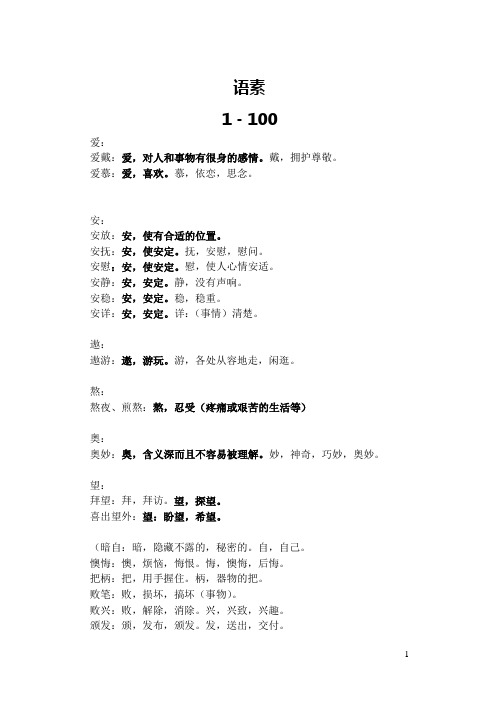
语素1-100爱:爱戴:爱,对人和事物有很身的感情。
戴,拥护尊敬。
爱慕:爱,喜欢。
慕,依恋,思念。
安:安放:安,使有合适的位置。
安抚:安,使安定。
抚,安慰,慰问。
安慰:安,使安定。
慰,使人心情安适。
安静:安,安定。
静,没有声响。
安稳:安,安定。
稳,稳重。
安详:安,安定。
详:(事情)清楚。
遨:遨游:遨,游玩。
游,各处从容地走,闲逛。
熬:熬夜、煎熬:熬,忍受(疼痛或艰苦的生活等)奥:奥妙:奥,含义深而且不容易被理解。
妙,神奇,巧妙,奥妙。
望:拜望:拜,拜访。
望,探望。
喜出望外:望:盼望,希望。
(暗自:暗,隐藏不露的,秘密的。
自,自己。
懊悔:懊,烦恼,悔恨。
悔,懊悔,后悔。
把柄:把,用手握住。
柄,器物的把。
败笔:败,损坏,搞坏(事物)。
败兴:败,解除,消除。
兴,兴致,兴趣。
颁发:颁,发布,颁发。
发,送出,交付。
伴随:伴,陪伴,陪同。
随,跟。
傍:依傍、依山傍水:傍:靠,靠近。
傍晚:傍:临近(指时间)暴:暴怒、暴雨:暴:突然而且猛烈。
悲:悲哀、悲惨、悲凉、悲伤、悲痛:悲:伤心难过。
痛:悲痛:悲伤。
深恶痛疾:尽情地、深切地、彻底地。
奔:奔驰:奔:奔走,急跑。
奔丧:奔:紧赶,赶忙或赶急事。
鄙:卑鄙:鄙:粗俗低下。
鄙视、鄙夷:鄙: 轻视,看不起。
拙:笨重:1费力气的2庞大沉重,不灵巧。
笨拙:拙:不灵巧,不灵活。
(重:笨重:重:重量大。
郑重、珍重:重:不轻率敬重、尊重:重:重视。
(比:比较、比赛:比:较量比拟:比:1比较2修辞方式,把物拟做人或把人拟做物。
今非昔比:比:能够相比(较:比较:较:比较(高低大小等)斤斤计较:较:计较(计算比较)拟:比拟:拟:相比模拟:拟:模仿迫:迫不得已、逼迫、强迫:迫:用压力促使。
(惨:悲惨:惨:凄惨。
惨淡:惨:1暗淡无色2凄凉,萧条,不景气3形容苦费心力。
(伤:悲伤:伤:伤心、难过。
伤痕:伤:人体或其他物体受到的损害。
触目伤怀:伤:伤害,损害。
动词必须(词义):①表示事理上和情理上的必要。
英语词素分类速记

词汇词素Lexical morphe mes自由词素:词根 E.g. car, talk, friend, tour, book, desk, house, loveFree morphe mes不能拆开功能词素Functio nal morphe mesE.g. and, but, becaus e, if, when, on, above, in, it, the, tha词素Morphemes派生词缀Derivat ional morphe mes改变意义或词类或创新词粘附词素:词缀 E.g. useles s, beauti ful (suffix es); irrele vant, discov er (prefix es) Boundmorphe mes可以拆开屈折词缀Inflect ional morphe mes不改变意义,语法信息E.g. wife----wives只能是后缀派生(derivational)词素和曲折(inflectional)词素粘着词素又可分为派生和曲折两类词素。
派生词素既能改变意义(如fit 和unfit,这两个词都是形容词,但意义相反),或者改变词类(如broad和broaden),或者既改变意义又改变词类来派生或创造新词。
曲折词素既不改变意义也不改变词类,只是给词的现有意义增加一些语法信息(如cat 和cats 都是名词,意义相同,但cats 多了一个表示名词复数的-s,这个-s 只起语法作用,被称为曲折词素。
派生词素可以是前缀,也可以是后缀。
但曲折词素只能是曲折。
英语中有八个曲折词素:动词第三人称单数的-s,动词过去式的-ed,现在分词-ing,过去分词-en,名词复数-s,名词所有格-‘s,形容词比较级和最高级的-er 和-est。
(完整版)初中语文知识——词的分类(词性介绍)

初中语文知识—-词的分类(词性介绍)一。
词性分类:实词:表示实在意义的词,有名词、动词、形容词、数词、量词、代词。
虚词:不表示实在意义而表示语法意义的词,有:副词、介词、连词、助词、叹词、拟声词。
二、具体定义和例子:1。
【名词】是表示人或事物名称的词。
又称体词。
实词的一种。
如:中国、世界、成果、效率、品德、父亲、主人、老李、疯子、错儿、孩子们等.名词可以分为以下次类:个体名词,又叫可数名词。
如:(一本)书、(三朵)花、(五条)河。
集合名词,不能加个体量词,与集合量词或不定量词”对,批,部分,些"等搭配,如:(一对)夫妇、(一部分)船只、(一些)车辆.专有名词,如:北京、天安门、孔子、长江。
时间名词,如:春天、上午、现在、立春、星期二、刚才。
处所名词,如:颐和园、商店、亚洲、北京、中国。
方位词,如:东、西、上、里、前、内.名词的主要语法特点:(1)不能用"不"来否定,如不能说"不帽子".(2)在句中经常充当主语、宾语、定语。
时间和处所名词可以做状语,如:小李昨天迟到了。
(3)名词一般不能重叠,只有带有量词性质的名词才可以重叠,如:人、年、天。
2.【动词】是表示人、事物的运动或相互作用的词(表示动作行为、发展变化、心理活动的词)。
动词可分为:及物动词和不及物动词。
能够带宾语的动词是及物动词,如:吃、打、敲、写,它们的宾语可以出现,也可以不出现.也有一部分动词必须带宾语,如:费(劲)、顾全(大局)。
不及物动词不可带宾语,如:咳嗽、休养、毕业.心理活动动词。
这类动词可以受”很、太”一类程度副词的修饰。
如:爱,想,同意,赞成,怀疑。
判断动词。
最主要的就是"是",表示判断或肯定。
在表示判断时,"是"后边的成分是"判断宾语",例如:"我是中国人。
”能愿动词,又叫助动词,表示行为状况的可能性或意愿性。
英语单词词素

英语单词词素(共3页)--本页仅作为文档封面,使用时请直接删除即可----内页可以根据需求调整合适字体及大小--英语中的词素词素是最小的语法单位,也是最小的语义单位。
一.自由词素自由词素本身具有完整意义并能作为“简单词”而独立使用的词素,比如 boy(男孩),girl(女孩),desk(椅子),kind(仁慈的),cruel(残酷的),give(给),take(拿)等都属于这一类。
自由词素可以充当词根(Root)加上词缀(Affix)构成派生词。
例如:kind: kind ness, un kind, un kind ness, kind lyfriend: friend ly, friend ship, friend less, un friend ly, un friend liness自由词素还可以和其他的自由词素组合,构成复合词,例如: book: book mark, book worm, book shop, book stalltake: in take, take-home, take-over, take-off, take away, under take 二.粘附词素粘附词素是指一些本身没有意思或词义或者没有完整的词义,不能单独存在、而必须黏附在其他形式上的词素。
a)词缀粘附词素额主要功能是构词上充当词缀,包括屈折词缀和派生词缀。
屈折词缀在现代英语中寥寥可数,包括名词复数标志-s/ -es; 名词属格标志-‘s: 第三人称动词单数现在时标记-s/-es;动词过去时标记-ed;动词-ed分词和-ing分词,形容词和副词比较级和最高级标记-er,-est等。
派生词缀分为前缀和后缀,构成派生词。
前缀后缀前后缀anti-war Marx ist un luck ypost war move ment co-exist encesspan-African care less in appropriat enessco-exist careless ness pre-liber ation表示相同意义的词素在不同的环境中可有不同的变体,这叫做词素变体,词素变体可表现在拼法上,如形容词的否定前缀有一下的变体:in im il ir-in active im mature il legal ir rationalin coherent immortal il logical ir regularin experience im perfect il legible ir regularin secure im practical il legitimate ir relevant词素变体也可以表现在语音上,如复数标记在cats中为/z/,在dogs 中为/z/,而在horses中则为/iz/。
关于词的分类的介绍Word版

词的分类及词性介绍一.词性分类:实词:表示实在意义的词,有名词、动词、形容词、数词、量词、代词。
虚词:不表示实在意义而表示语法意义的词,有:副词、介词、连词、助词、叹词、拟声词。
二、具体定义和例子:1.【名词】是表示人或事物名称的词。
又称体词。
实词的一种。
如:中国、世界、成果、效率、品德、父亲、主人、老李、疯子、错儿、孩子们等。
名词可以分为以下次类:个体名词,又叫可数名词。
如:(一本)书、(三朵)花、(五条)河。
集合名词,不能加个体量词,与集合量词或不定量词"对,批,部分,些"等搭配,如:(一对)夫妇、(一部分)船只、(一些)车辆。
专有名词,如:北京、天安门、孔子、长江。
时间名词,如:春天、上午、现在、立春、星期二、刚才。
处所名词,如:颐和园、商店、亚洲、北京、中国。
方位词,如:东、西、上、里、前、内。
名词的主要语法特点:(1)不能用"不"来否定,如不能说"不帽子"。
(2)在句中经常充当主语、宾语、定语。
时间和处所名词可以做状语,如:小李昨天迟到了。
(3)名词一般不能重叠,只有带有量词性质的名词才可以重叠,如:人、年、天。
2.【动词】是表示人、事物的运动或相互作用的词(表示动作行为、发展变化、心理活动的词)。
动词可分为:及物动词和不及物动词。
能够带宾语的动词是及物动词,如:吃、打、敲、写,它们的宾语可以出现,也可以不出现。
也有一部分动词必须带宾语,如:费(劲)、顾全(大局)。
不及物动词不可带宾语,如:咳嗽、休养、毕业。
心理活动动词。
这类动词可以受"很、太"一类程度副词的修饰。
如:爱,想,同意,赞成,怀疑。
判断动词。
最主要的就是"是",表示判断或肯定。
在表示判断时,"是"后边的成分是"判断宾语",例如:"我是中国人。
"能愿动词,又叫助动词,表示行为状况的可能性或意愿性。
词素分类0.1之欧阳与创编

这个问题问得很好.所谓词性是指词的语法功能,即词能在句中作什么成分,是名词就具有单复数之分,是动词就有时态之分,是形容词就可以作定语或状语等,但语素是构词成分,它不可能具有上述各项功能,因此语素是没有词性的语素不能按动名形分类。
只有词才有词性。
词根语素能,非词根语素不能,不矛盾吗?“词根语素”既能作为词,又能作为语素,分类是它作为词时的分类,不能认为它作为语素身份时也能分类。
愚见。
未知当否。
素Morphemes 分为两种, 自由词素(Free Morpheme)和粘着词素(Bound Morpheme)。
自由词素是能够作为一个词而**存在的词素。
它通常具有独特的词汇意义,能单独构成一个词,也可以相互结合或与其他形式结合而形成新词,这时自由词素被称为词根(Root). 由于自由词素所具有的完整的词汇意义,所以它也被称为“Content Morpheme”。
自由词素具有较强的构词能力。
它可以是简单的单词,如boy, girl, do, go等。
也可以是派生词的词根,如im-polite, self-ish等。
粘着词素没有完整意义,不能**使用,只有粘附在其他词素(主要是自由词素)上表示一种附加意义或语法意义,所以它又被称为“Grammatical Morpheme”。
黏着词素,顾名思义,是必须黏附在其它词素上构成单词,它们不能作为单词独立使用,如,helpful 中的-ful就是一个黏着词素。
黏着词素分为词根和词缀两类。
词根是单词的一部分,经管它们有着明确的语义,但是它们不能单独使用,必须和其它词素或词根结合使用构成单词。
例如;在单词antecedENT 中,ante- 是前缀,表示before, -ced-是词根,意思是go, -ent是后缀,表示a thing or a person。
词素前缀一、否定前缀1.纯否定not①a-②dis-③in-④non-⑤un-2.倒转,去除toreverse, to remove①de-②dis-③un-3.反对,抗,相对against, opposite to①anti-②contra-③counter-④ob-二、空间方位前缀1.前←→后❖前①ante- (before)②fore-(before)③pre-(before)④pro-(forward)❖后①post-(after)②re-(backward)③retro-(backward)2.上←→下❖上①over-(above, on;excessive, toomuch)②super-(above,beyond)③sur-(over, above)④hyper-(excessive,too much)⑤epi-(above)❖下①sub-(undre)②de-(down)③under-(below;less than)④hypo-(under,beneath)⑤infra-(below)3.内←→外❖内①in-(in, enter)②im-(in, inward,enter)③intro-(in,inward)④intra-(inside)⑤en-(in)em- (b, m, p前)❖外①e-(out)②ex-(out)③extra-(outside of,beyond)④ultra-(beyond)⑤out-(surpassing,out)4.中间←→周围❖中间①inter-(between)②mid-(in themiddle of)❖周围①circum-(round,around)三、对比前缀1.大←→小❖大①macro- (large)②mega-(large)③magn-(big,great)❖小①micro-(verysmall)②mini-(small)2.多←→少❖多①multi- (many)②poly-(many)❖少①under-(less than,not enough)3.好←→坏❖好①bene- (good,well)②eu-(good, well)❖坏①mal-(bad)male-②mis-(bad)4.新←→旧❖新①neo- (new)❖旧①old-(very small)②pale-(very old,of ancient time)paleo-5.朝向←→离开❖朝向①ad- (to, toward)❖离开①ab-(away, off)②di-(away)6.相同←→不同❖相同①homo- (same)❖不同①hetero-(different)7.聚合←→分散❖聚合①co- (together)②syn-(together,same)sym-❖分散①dis-(apart)②se-(apart)8.正确←→错误❖正确①ortho- (right,straight)❖错误①mis-(wrong)9.喜爱←→憎恶❖喜爱①phil- (liking,fond of)❖憎恶①mis-(hate)10.全←→半❖全①holo-(complete)②omni-(all oreverywhere)③pan-(all)❖半①half-②semi-(half,partially)③hemi-(half)④demi-(half)四、数字前缀1.一①mono- (one,single)②uni-(one, single)二①bi- (two, twice)②twi-(two)③di- (two,double)du-④ambi-(both)⑤amphi- (both)2.三①tri- (three)3.四①quadri- (four)②quarter-(onefourth)4.五①penta- (five)②quinque-(five)5.六①sex- (six)②hexa-(six)6.七①hepta- (seven)7.八①octa- (eight)8.九①nona- (nine)9.十①deca- (ten)heci-10.百①hecto-(hundred)②centi-(hundred)11.千①kilo-(thousand)②milli-(thousand)12.万①myria-13.百万,兆,大量①mega- (six)五、其他前缀1.横过(到对面),穿过①dia- (through,across)②trans-(through,across)③per-(through,across)2.自己,自动①auto-(self)3.心灵,精神,心理①psycho- (mind)4.假的,伪的①pseudo- (false)5.继(无血缘关系)①step- (not byblood)6.改变①trans- (change)7.远①tele- (far,distant)六、改变词性前缀1.a-①将动词变成谓语性形容词alike②将名词变成副词ahead③将名词变成动词amass2.be-①在名词或形容词前,构成及物动词befriend②构成一些介词before3.en- (b, p, m 前为em-)①构成动词enable七、多义前缀1.a-①改变词性②否定not③状态④place where2.ad-①to toward②again, to add3.be-①改变词性②构成介词4.de-①to remove, toreverse②down5.di- (du-)①two, double②away6.dis-①not②to reverse, toremove③apart7.en- (em- b, p, m前)①in②构成动词8.ad-①out②former9.in- (im- b, p, m前)①not②inside, to enter10.mis-①bad②wrong③to hate11.over-①above, on②excessive, toomuch12.re-①to undo, toreverse②backward③again13.trans-①across②through③to change14.un-①not②to reverse15.under-①beneath, below②less, not enough后缀一、名词后缀1.表示“人”1)inhabitants ordwellers①-an②-er③-ese 2)belonging to acertain occupation①-ian (c, y结尾的形容词或名词后)②-er3) a supporter orbeliever of adoctrine①-an②-arian③-ist4)one who does orperforms an act①-ar②-ary③-ate④-ator⑤-ist⑥-ee⑦-eer⑧-or5)to denote a specificfeeling①-ster(a bad sense贬义)②-y(dearness 亲昵)6)To form a femininenoun①-ess2.抽象1)state or quality①-ance, -ancy附在-ant结尾的形容词后附在动词词根后②-ence, -ency附在-ent结尾的形容词后③-cy附在-te, -tic结尾的词干后④-ability附在-able结尾的形容词后⑤-ibility附在-ible结尾的形容词后⑥-ness附在形容词后2)the action & theresult of the action①-al (the act of)②-ion, -sion, -tion③-ment (theresult of anaction)④-ure (action orresult)3)indicate abstractconcepts①-ship (state orcondition of)②-th③-tude4)power, rule,government①-cracy5)action, state orcondition, doctrines,example of a use①-ism6)state, condition①-hood②-age7)relationship, status,identity①-ship3.学科①-ic, -ics②-logy4.物质(物品和工具)①-al②-er③-ery5.细小①-cle②-en③-ette④-ling⑤-let二、形容词后缀1.可……的,能……的,易于……的1)-able2)-ible3)-ile2.如……的,似……的,……形状的1)-esque2)-ish3)-like4)-y5)-ly3.有……的,多……的1)-ed2)-ful3)-ous4)-y4.属于……的,与……有关的1)-al2)-an3)-ar4)-ial5)-ic6)-tic7)-ual5.具有……性质的1)-acious2)-aneous3)-ant4)-ar5)-ary6)-ate7)-ative8)-atory9)-ed10)-fic11)-ful12)-ical13)-id14)-ious15)-ite16)-itive17)-ive18)-ly19)-ory20)-ous21)-some6.某国的,某地的1)-an2)-ese3)-ian4)-ish7.其它1)-ing①使……的exciting②正……在的developing2)-ed①已……的retired②受……的educated3)-ish 略……的,稍……的greenishcoldish4)-less 无……的useless5)-proof 防……的,不透……的waterproofairproof三、动词后缀1.to make; to cause tobecome①-ate②-en③-fy④-ish⑤-ize⑥-ise (BrE)2.repeated orcontinuous action①-er3.onomatopoeicaction①-sh四、副词后缀1.方式,方法,状态,……地①-ably②–ibly③–ly (一般加在形容词后)2.表示方向①-ward②-wise五、多义后缀1.-al①与……有关,有……的特点autumnal②……的行为refusal③物品manual2.-an①……国(人)European②支持(信仰)……的Christian③职业librarian3.-ar①加在名词后,构成形容词singular②加在动词后,构成名词liar4.-ate①表现出……的,充满……的considerate②使……,使成为……regulate③机构或部门consulate5.-er①加在动词后,构成名词fertilizer②职业,工作banker③……地方或国家的人northerner④构成形容词或副词比较级smaller harder6.-ish①像……一样的,有……特点的snobbish②……国的,……语的BritishEnglish③沉迷于……的,倾向于……的bookish④稍许,有点儿sweetish⑤动词后缀nourish7.-ism①加在动词后,构成名词criticism②动作,事业tourism③状态,状况alcoholism④学说,主义,信条socialism⑤语言上的用法和特点witticism8.-ly①加在形容词后,构成副词gradually②加在表示时间的名词前,构成形容词或副词;每……的weekly③像……一样的,具有……性质的worldly9.-ment①行为movement②行为的结果、状态refreshment③行为后的具体产物pavement10.-ship①状态,身份membership②技巧,能力leadership③关系kinship11.-y①有……的,表现出……的,像……一样的silvery②亲昵mummy③加在动词后,构成名词。
3词素201最新整理3

worked, helped; piled, learned; wanted, landed
invention, justification, expansion
3. Classifications of morphemes
• Capacity of occurring alone free vs. bound morphemes
• Functions of affixes derivational vs. inflectional morphemes
• Phonetic (音) allomorphs [s, z, iz] of the plural morpheme –s: cats, ships, books; beds, jobs, dogs, fools; classes, dishes, damages, garages, matches
Bound morpheme>affixes
• Two types of affixes: Inflectional affixes (inflectional morpheme) and Derivational affixes (derivational morpheme)
2020/12/26
Affixes= derivational + inflectional morphemes
What’s the difference between them?
Inflectional
- 1、下载文档前请自行甄别文档内容的完整性,平台不提供额外的编辑、内容补充、找答案等附加服务。
- 2、"仅部分预览"的文档,不可在线预览部分如存在完整性等问题,可反馈申请退款(可完整预览的文档不适用该条件!)。
- 3、如文档侵犯您的权益,请联系客服反馈,我们会尽快为您处理(人工客服工作时间:9:00-18:30)。
In linguistics, a morpheme is the smallest grammatical unit in a language. In other words, it is the smallest meaningful unit of a language. The field of study dedicated to morphemes is called morphology. A morpheme is not identical to a word, and the principal difference between the two is that a morpheme may or may not stand alone, whereas a word, by definition, is freestanding. When it stands by itself, it is considered as a root because it has a meaning of its own (e.g. the morpheme cat) and when it depends on another morpheme to express an idea, it is an affix because it has a grammatical function (e.g. the–s in cats to indicate that it is plural).[1]Every word comprises one or more morphemes.在语言学,一个语素是最小的语法单位的语言。
换句话说,它是最小的有意义的语言单位。
领域的研究致力于词素形态。
语素是不相同的词两者之间的主要区别是,一个语素可能或可能不独立,而一个词,根据定义,是独立的。
当它本身,它被认为是一个根因为它有一个自己的(例如语素的意义猫),当它取决于另一个语素表达一个想法,它是一个词缀,因为它有一个语法功能(例如- s在猫表明它是复数)。
[1]每一个字都包含一个或多个语素。
Classification of morphemes[edit]Free and bound morphemes[edit]Every morpheme can be classified as either free or bound.[2] These categories are mutually exclusive, and as such, a given morpheme will belong to exactly one of them.Free morphemes can function independently as words (e.g. town, dog) and can appear with other lexemes (e.g. town hall, doghouse).Bound morphemes appear only as parts of words, always in conjunction with a root and sometimes with other bound morphemes. For example, un- appears only accompanied by other morphemes to form a word. Most bound morphemes in English are affixes, particularly prefixes and suffixes. Examples of suffixes are -tion, -ation, -ible, -ing, etc. Bound morphemes that are not affixes are called cranberry morphemes.语素的分类(编辑]自由和黏着语素(编辑每一个语素可以分为免费或绑定。
[2]这些类别是相互排斥的,因此,一个给定的语素将属于正是其中之一。
自由语素(如可以独立运行的话。
小镇,狗),会出现与其他词位(如。
市政厅,狗窝)。
黏着语素仅出现部分单词,总是与一个根有时与其他绑定语素。
例如,联合国-只出现伴随着其他语素组成一个单词。
英语中最黏着语素词缀,特别是前缀和后缀。
后缀的例子有表示结果,信息,可能,ing等等。
没有词缀叫做绑定语素蔓越莓词素。
Classification of bound morphemes[edit]Bound morphemes can be further classified as derivational or inflectional.Derivational morphemes[edit]Derivational morphemes, when combined with a root, change either the semantic meaning or part of speech of the affected word. For example, in the word happiness, the addition of the bound morpheme -ness to the root happy changes the word from an adjective (happy) to a noun (happiness). In the word unkind, un- functions as a derivational morpheme, for it inverts the meaning of the word formed by the root kind. Generally the affixes used with root word are the bound morphemes. Inflectional morphemes[edit]Inflectional morphemes modify a verb's tense, aspect, mood, person, or number, or a noun's,pronoun's or adjective's number, gender or case, without affecting the word's meaning or class (part of speech). Examples of applying inflectional morphemes to words are adding -s to the root dog to form dogs and adding -ed to wait to form waited. An inflectional morpheme changes the form of a word. In English, there are eight inflections.[3]Allomorphs[edit]Allomorphs are variants of a morpheme that differ in pronunciation but are semantically identical. For example, in English, the plural marker -(e)s of regular nouns can be pronounced /-z/, /-s/, or /-ɪz, -əz/, depending on the final sound of the noun's singular form.Zero morphemes/null morphemes[edit]Generally these types of morphemes have no visible changes. For instance the singular form of sheep is "sheep" and its plural is also "sheep". The intended meaning is thus derived from the co-occurring determiner (e.g. in this case "some-" or "a-").Content vs. function[edit]Content morphemes express a concrete meaning or content, while function morphemes have more of a grammatical role. For example, the morphemes fast and sad can be considered content morphemes. On the other hand, the suffix –ed belongs to the function morphemes given that it has the grammatical function of indicating past tense. Although these categories seem very clear and intuitive, the idea behind it can be harder to grasp given that they overlap with each other.[4] Examples of an ambiguous situation are the preposition over and the determiner your, which seem to have a concrete meaning, but are considered function morphemes because their role is to connect ideas grammatically.[5] A general rule to follow to determine the category of a morpheme is:Content morphemes include free morphemes that are nouns, adverbs, adjective, and verbs. It also includes bound morphemes that are bound roots and derivational affixes.[5]Function morphemes can be free morphemes that are prepositions, pronouns, determiners, and conjunctions. Additionally, they can be bound morphemes that are inflectional affixes.[5]黏着语素的分类(编辑]黏着语素可以进一步分为派生或屈折。
